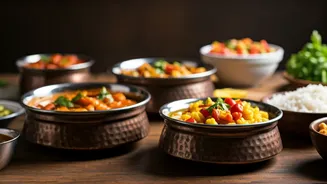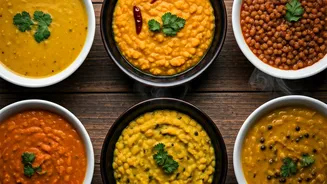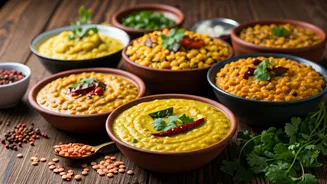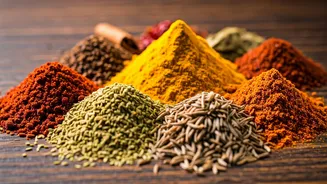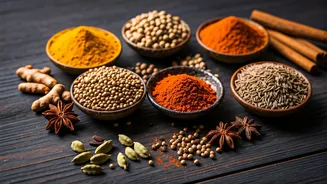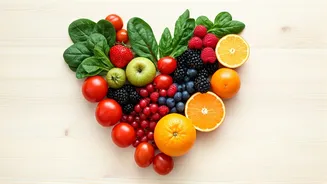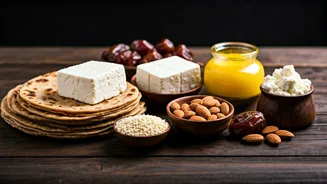Embrace Meal Prep
Meal prepping, the practice of preparing meals in advance, is a game-changer for those seeking to eat healthy consistently. It's especially beneficial
in today's fast-paced world, where time is a precious commodity. For busy individuals in India, meal prepping can be the key to enjoying home-cooked, nutritious meals even during hectic work weeks. By dedicating a few hours each week, you can prepare several meals at once, ensuring that you always have a healthy option readily available. This method reduces the temptation to order takeout or reach for unhealthy snacks. Meal prepping also helps to control portion sizes and manage calorie intake, contributing significantly to weight management and overall health improvement. A well-planned meal prep strategy can also help you save money by reducing food waste and making it easier to stick to a budget. When preparing Indian meals, consider utilizing readily available ingredients like lentils, vegetables, and rice to create a variety of delicious and nutritious dishes.
Essential Indian Ingredients
To successfully prepare Indian meals, you'll need to stock your pantry with essential ingredients that form the foundation of these flavorful dishes. Start with staples like rice (both basmati and brown rice), various types of lentils (such as masoor dal, chana dal, and toor dal), and whole wheat flour (atta). Spices are crucial for imparting authentic flavors, including turmeric, cumin, coriander, garam masala, chili powder, and mustard seeds. Consider stocking up on fresh ginger and garlic, which are widely used in Indian cooking. For healthy fats, include ghee or coconut oil. Vegetables, such as potatoes, cauliflower, spinach, tomatoes, and onions, are also frequently used. Don't forget herbs like cilantro and curry leaves for garnish and flavour enhancement. By having these ingredients on hand, you can whip up a wide array of Indian meals that are both healthy and satisfying. When shopping, opt for fresh and locally sourced ingredients whenever possible to support local farmers and ensure the best flavors.
Meal Prep Strategies
Effective meal prep involves smart planning and efficient execution. Begin by creating a meal plan for the week, considering your dietary needs and preferences. Start by browsing Indian recipes online or from cookbooks and noting down the ingredients required. Once you've chosen your recipes, make a shopping list to ensure you have everything you need. On your prep day, allocate specific time slots for cooking different components of your meals. For example, you can cook a large batch of rice or lentils, chop vegetables, and prepare spice blends ahead of time. Store cooked components in separate containers to maintain freshness and prevent flavors from mixing unnecessarily. Label each container with the date and contents for easy identification. Choose recipes that work well for meal prepping, such as curries, vegetable stir-fries, and lentil-based dishes. Preparing these in bulk and portioning them out simplifies your week's meals. Another tip involves making use of your refrigerator's space effectively to store prepared components and assembled meals. Try to use clear containers to make it easier to see what you have available and to reduce food waste.
Lentil-Based Delights
Lentils are a cornerstone of Indian cuisine, offering a rich source of protein and fiber. They're also incredibly versatile and easy to incorporate into meal-prepped dishes. One popular option is Dal Makhani, a creamy black lentil dish that tastes better the longer it sits, making it ideal for meal prep. Another great choice is Dal Palak, a spinach and lentil curry packed with nutrients and vibrant flavor. For a quick and easy option, consider preparing a simple masoor dal (red lentil) curry, seasoned with cumin, turmeric, and other spices. Lentils can also be used in various salads and side dishes to add a protein boost and texture. When prepping, you can cook a large batch of lentils and then use them in different recipes throughout the week. Be sure to cook lentils until they are tender but still hold their shape. The cooking time varies depending on the type of lentil used; hence, proper timing is essential. Lentils can be paired with rice, roti, or vegetables, making them perfect for building balanced and nutritious meals.
Vegetable-Packed Meals
Vegetables are a vital component of any healthy Indian diet, and they should feature prominently in your meal prep plans. Prepare a variety of vegetable dishes that cater to your taste preferences and nutritional requirements. Sabzi, a general term for vegetable preparations, provides countless options, from Aloo Gobi (potato and cauliflower) to Bhindi Masala (okra). Mix and match your vegetables for the best outcome. Ensure you include leafy greens like spinach or fenugreek, as these are high in vitamins and minerals. Preparing a large batch of mixed vegetables with various spices and herbs can create a flavorful and well-balanced meal. You can also roast or grill vegetables to enhance their natural sweetness and texture. When meal prepping, pre-chop and store vegetables in separate containers to save time. Adding fresh herbs like cilantro or mint can elevate the taste of your vegetable dishes just before serving. By embracing the versatility of Indian vegetables, you can create a wide array of delicious and nutritious meals, contributing to a vibrant and healthy lifestyle.
Rice and Roti Essentials
Rice and roti are fundamental components of the Indian diet, forming the base of many meals. Both provide a source of carbohydrates, and the choice between them often depends on personal preference and the specific meal. For meal prepping, cook large batches of rice, such as basmati or brown rice, which can be stored in the refrigerator for several days. Brown rice is a more nutritious option, as it contains more fiber and nutrients. Prepare roti ahead of time, too, by making the dough and then cooking them. Roti can be wrapped in foil or stored in an airtight container to maintain their softness. For a healthier option, use whole wheat flour for making the dough. You can easily reheat rice and roti to enjoy with your prepped curries and vegetable dishes throughout the week. Portioning your rice and roti helps to control portions and ensures that you maintain a balanced meal. Experiment with different types of grains and flours to diversify your diet and add interest to your meals. By incorporating these staples into your meal prep plan, you can create satisfying and nutritious meals that support your overall health and well-being.
Flavor Enhancements & Spices
Spices and herbs are the soul of Indian cuisine, transforming simple ingredients into flavorful and aromatic dishes. Mastering the art of using spices is crucial for creating authentic and satisfying meals. Start with essential spices like turmeric, cumin, coriander, and garam masala. These can be used individually or combined to create different flavor profiles. Freshly ground spices often provide a stronger flavor compared to pre-ground ones. Experiment with different spice combinations to discover your favorite tastes. Fresh herbs like cilantro, mint, and curry leaves also add freshness and depth of flavor to your dishes. When meal prepping, you can prepare spice blends in advance to save time. Keep in mind that different spices have varying levels of heat. Chili powder or cayenne pepper can be added for extra heat, while ingredients like ginger and garlic impart warmth. By experimenting with spices and herbs, you can create a diverse and exciting range of Indian meals, each with its unique and delicious flavor profile. Storing spices properly (away from direct sunlight and heat) maintains their potency and flavour for a longer time.
Portion Control & Storage
Effective portion control is crucial for maintaining a healthy diet and achieving your weight management goals. Meal prepping simplifies portion control by allowing you to pre-portion your meals and snacks. Use appropriately sized containers to store individual servings of your prepared meals. This helps to prevent overeating and ensures that you consume the right amount of calories and nutrients. Proper storage is vital to keep your meals fresh and safe to eat. Store your meal-prepped meals in airtight containers in the refrigerator. Most meals can be stored in the refrigerator for 3-5 days. For longer storage, you can freeze individual portions. Label your containers with the date and contents for easy identification and to keep track of freshness. When reheating your meals, ensure that they are heated thoroughly to eliminate the risk of foodborne illnesses. Use appropriate utensils and maintain proper hygiene while handling food. Consider your lifestyle and dietary needs when determining portion sizes. With these measures in place, you can ensure that your meal prep efforts are effective, healthy, and convenient.
Sample Meal Prep Plans
Creating a sample meal prep plan provides a solid framework to jumpstart your healthy eating journey. Here's a sample plan: For Breakfast, consider a breakfast of vegetable-stuffed parathas with a side of yogurt. Lunch can consist of lentil curry (dal) with brown rice and a side of mixed vegetables. Dinner can be a chicken curry (if you are non-vegetarian) or paneer curry (if you are vegetarian) served with roti or rice. For snacks, carry fruits, nuts, or a small portion of homemade chivda. This plan ensures you include a variety of nutrients and keeps you energized throughout the day. You can modify these suggestions to fit your own preferences and dietary needs. If you like, you can substitute ingredients based on your personal taste and accessibility. Remember to adjust portion sizes to meet your calorie needs. Meal prepping is about finding a sustainable method that fits your schedule and supports your health goals. Consider adding variety by including different types of lentils, vegetables, and protein sources. Make it enjoyable by experimenting with different spices and flavor combinations.
Staying Consistent & Inspired
Maintaining consistency is crucial for long-term success with meal prepping. It's easy to lose momentum, but some strategies can help you stay motivated. First, make meal prepping a weekly ritual by blocking out time in your schedule. Ensure you plan your meals on the weekend, and dedicate time to shop for groceries and prepare your meals. Keep a log of your meal prep plans to track your progress and make adjustments. Find inspiration in cookbooks, food blogs, or social media for new recipes and ideas. Try different cuisines and flavor combinations to keep things interesting. Involve family members or friends in meal prepping to share the workload and make it a social activity. Meal prepping isn’t just about the food; it's about investing in your overall health and well-being. Reward yourself for sticking to your meal prep routine to stay motivated. By consistently putting in the effort, you'll see positive changes in your eating habits, energy levels, and overall health. Embrace this journey as an opportunity to discover new flavors and create a healthier version of yourself.
